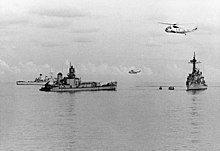Defence Industry Minister Pat Conroy has announced a $180 million commitment over the next five years to modernise and enhance the anti-ship missile defences of the Royal Australian Navy’s major surface combatants.
Rheinmetall Defence Australia signed a contract to build Multi-Ammunition Softkill System (MASS) to equip Anzac Class frigates and Hobart Class destroyers with anti-ship missile protection — this system provides an electromagnetic decoy to protect the naval ships from sensor-guided, anti-ship missiles.
Defence Industry Minister Pat Conroy welcomed the announcement, saying this deal with a Queensland-based facility was a testament to the strength of Australia’s defence industrial base.
“It is great to visit the Brisbane facility where this exciting new system will be developed with support from a number of local companies, creating Queensland jobs,” Minister Conroy said.
The five-year contract will focus on building the capability at a facility in Brisbane, creating up to 45 new local jobs through supply and support chains. This is in addition to over 600 local jobs currently being supported at the facility.
“This investment will not only keep our sailors safe, but also lead to a smarter, stealthier navy, able to protect Australia’s interests in our current strategic environment,” Minister Conroy added.
The government is working closely with defence industry to reshape the Australian Defence Force to respond to Australia’s current strategic circumstances outlined by the Defence Strategic Review.
Going further, the minister’s release explained the importance of capabilities such as this, saying, “Australia has lost the 10-year warning period for any conflict, with the review recommending urgent action to build Australia’s military preparedness, including in the maritime domain. This new capability will protect our Defence personnel, enabling them to keep Australians safe.”
Minister Conroy said, “The Albanese government is investing in sovereign capabilities and working with local industry to ensure our Defence personnel have the capability they need to keep Australians safe.”















